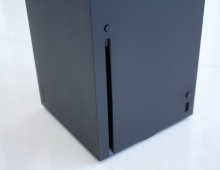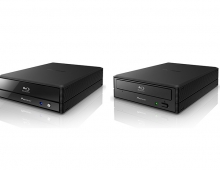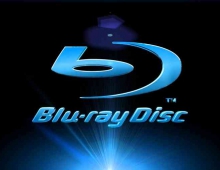
CeBIT Blu-ray Press Conference Details
At the Blu-ray press conference at CeBIT, in Hannover on Thursday three main Blu-ray heavyweight supporters spoke to the crowd about the current situation and the advantages of the next-generation format they chose to adopt.
Frank Simonis, marketing manager of Philips optical storage was proud to announce that Blu-ray's board of directors now includes 17 members with Warner Bros.He also added that the next-generation Blu-ray format is also backed by 140 brand names and 175 members-contributors, which shows, according to Mr. Simonis, that the support has increased since last year's CeBIT show.
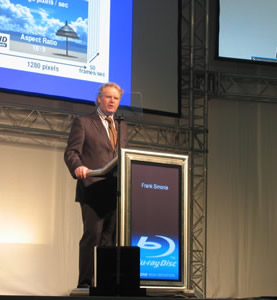 Mr Simonis also compared the Blu-ray format with the HD-DVD one in terms of storage trying to convince the companies and journalists of the BD superiority. He emphasized the importance of the high capacity offered by the Blu-ray format, compared with the HD DVD. He claimed that the provided high capacities, which will reach the 50GB in double layer discs, would allow storing of high definition content featuring higher bitrates and thus, better picture quality. Compared to the HD DVD, the BD-ROM disc is able to offer a 47% higer transfer rate (54Mbps), while in case of BD-RE /R (2x) media, the maximum transfer rate reaches the 72Mbps. Note that the maximum bit rate for an AV stream is 48Mbps.
Mr Simonis also compared the Blu-ray format with the HD-DVD one in terms of storage trying to convince the companies and journalists of the BD superiority. He emphasized the importance of the high capacity offered by the Blu-ray format, compared with the HD DVD. He claimed that the provided high capacities, which will reach the 50GB in double layer discs, would allow storing of high definition content featuring higher bitrates and thus, better picture quality. Compared to the HD DVD, the BD-ROM disc is able to offer a 47% higer transfer rate (54Mbps), while in case of BD-RE /R (2x) media, the maximum transfer rate reaches the 72Mbps. Note that the maximum bit rate for an AV stream is 48Mbps.
In addition, Mr Simonis claimed that the BD-ROM video disc is able to hold both HD video and HD audio more efficiently, compared to the HD DVD solution. For example, a 194 min HD video movie can be stored on a BD-ROM disc at a bit rate of 20Mbps (MPEG 2), allowing HD audio (LPCM 5.12ch, Dolby Digital etc) to be also stored on the disc.
Simonis concluded its speach by expressing his belief that the Blu-ray recorders/players will dominate the western European market in the next 2-3 years. Samsung and Panasonic is expected to launch their first BD recorders and players next August.
Sony also plans to launch desktop and laptop PCs with Blu-ray Disc drives in the middle of this year. The first computers to feature Blu-ray Disc drives will be high-end models aimed at multimedia use, but over time the technology will trickle down to other models, said Tasuku Yazaki, general manager of Sony's Vaio product planning department. The machines will be launched worldwide at around the same time, he said, without revealing product details. Mr Yazaki also emphasized Sony's approach in the HD video capturing, editing and streaming through the home network.
Sony Europe's Recording Media & Energy (RME) division also announced that its BD media will ship in Europe in March 2006. Single-layer BD rewritable media will be available in stores in mid March and single layer BD recordable media will be shipping in April. Sony also revealed that it's ready to release dual layer discs later this year.
Philipe Coppen of Pioneer's optical storage division again, emphasized in the fact that the high capacity and transfer rates provided by the Blu-ray format offer a big potential. Mr Coppen said that appart from the long time recording offered by the Blu-ray solutions, the recorders will offer high speed dubbing from a HDD recorder to a BD-R/RE disc.
Coppen also presented Pioneer's upcoming BD recorder for PCs, the BDR-101A (AACS enabled). The drive will support writing on single layer BD-R and BD-RW discs, DVD-R/+R (Sl and DL) and DVD-RW/+RW. In the reading part, the BDR-101A will additionally read BD-ROM (SL and DL) and DVD-ROM discs, including DVD-Video. Pioneer's next generation drive (BDR-102A) will possibly offer playback and recording of BD-R/RE DL, DVD-RAM and CD-R/RW media.
The BDR-101A will possibly come with SATA, e-SATA, and USB interfaces.
Moreover, the BDA spokesmen said that the production of the first double layer BD-ROM has began in an experimental product lines.
This year's BDA conference did not unveil any exciting news, and the BDA representatives did not give clear answers about some interesting issues related to the format, such as the AACS content protection schemes and the so-called "Managed Copy" issue, that would allow consumers to back up their BD-ROM video titles for use on another machine, such as a portable playback device. The currently available interim licensing for the copy protection system that will be used to protect high-definition Blu-ray formats does not include the many of the advanced features of the AACS specification such as "Managed Copy". The release of the still-incomplete interim specification enables hardware manufacturers to begin making Blu-ray devices as soon as April 2006, although most of them are expected to be available as soon as the final standard will be released later this year, possibly before August 2006. The final specs will likely include the more compelling features promised for Blu-ray.
When questionned on the copy protection issue, Frank Simonis responded that the AACS is not controlled by Blu-ray. He did not mention if consumers would have to switch to new products once this issue would be solved. However, he confirmed that the next-generation optical disc format will incorporate the interim version of the copy-protection technology.
The BD will ship with the format's BD+ and ROMmark security systems - both of which come in addition to AACS. BD+ allows the BDA to update at a future date the Blu-ray encryption keys should they be cracked or made public at a future date. ROMmark is essentially a 'genuine disc' stamp encoded on each BD as it comes out of a pressing machine.
Hardware availability
The BDA representatives also avoided to unveil the exact release dates for their hardware. Philips said it would launch Blu-ray players and writers in the second half of the year, and Samsung Electronics showed off what it called the first commercial player, to be launched at $1,000 in May in the United States.
Matsushita, which sells its products under the Panasonic and JVC brands, said its new Blu-ray players would be priced somewhere between Samsung's and feature-rich models from the likes of Pioneer at prices above $1,500.
Fujifilm announcedthat its Blu-ray discs will be available in spring 2006. They will deliver 25GB storage capacities in recordable and rewritable formats which can be used in drives with 1-2X writing speed.
Philips said that its BDP 9000 home entertainement player will be available in middle 2006 and the Triple Writer model, the SPD 7000 will be available in Europe and in America in the second half of 2006 also.
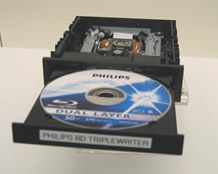
On the other hand, Toshiba said it would include an HD DVD drive in its most expensive laptop, which doubles as a high-definition television receiver. The firm has already announced it will launch HD DVD players this month, with prices starting at $499.
The Blu-ray group brushed aside suggestions the opposing camp could tip the balance with lower prices.
"When DVD (players) was launched, there was an array of products sold from $500 to $1,000. Oddly enough, the product that was sold at $1,000 had over 35 percent market share, and the one that was $499 had about 5 percent," said Blu-ray spokesman Frank Simonis.
"If you want a 35-inch screen and a true Dolby Digital solution, you have invested much more than the price of the playback device," he added.
Fujitsu-Siemens' Sehrm said the new drives would mainly be targeted at home-cinema enthusiasts in the beginning.
"The drives are 400 euros ($480) or something like that. It's a factor of 10 more expensive than the current ones. I don't think there is any business need for it to be honest," Sehrm said.
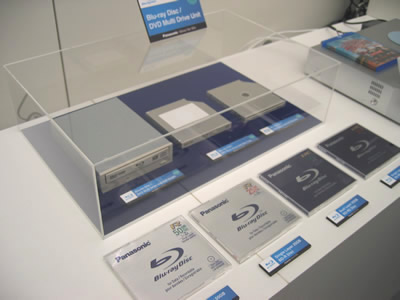
LG's European president, James Kim, said the firm, which unveiled Blu-ray optical drives for use in combination with a personal computer, said it expected the market to start slowly.
"It will be only in a few products (PCs). The product has not yet hit the sweet spot," Kim said, referring to low prices, which are needed to convince cost-conscious computer makers to include a Blu-ray optical drive in their products.
The BDA indicated the format's European launch timeframe will be formally announced after Blu-ray's US launch in May. This despite comments from Samsung, Panasonic and others that they will ship BD players in Europe next Autumn.
 Mr Simonis also compared the Blu-ray format with the HD-DVD one in terms of storage trying to convince the companies and journalists of the BD superiority. He emphasized the importance of the high capacity offered by the Blu-ray format, compared with the HD DVD. He claimed that the provided high capacities, which will reach the 50GB in double layer discs, would allow storing of high definition content featuring higher bitrates and thus, better picture quality. Compared to the HD DVD, the BD-ROM disc is able to offer a 47% higer transfer rate (54Mbps), while in case of BD-RE /R (2x) media, the maximum transfer rate reaches the 72Mbps. Note that the maximum bit rate for an AV stream is 48Mbps.
Mr Simonis also compared the Blu-ray format with the HD-DVD one in terms of storage trying to convince the companies and journalists of the BD superiority. He emphasized the importance of the high capacity offered by the Blu-ray format, compared with the HD DVD. He claimed that the provided high capacities, which will reach the 50GB in double layer discs, would allow storing of high definition content featuring higher bitrates and thus, better picture quality. Compared to the HD DVD, the BD-ROM disc is able to offer a 47% higer transfer rate (54Mbps), while in case of BD-RE /R (2x) media, the maximum transfer rate reaches the 72Mbps. Note that the maximum bit rate for an AV stream is 48Mbps.
In addition, Mr Simonis claimed that the BD-ROM video disc is able to hold both HD video and HD audio more efficiently, compared to the HD DVD solution. For example, a 194 min HD video movie can be stored on a BD-ROM disc at a bit rate of 20Mbps (MPEG 2), allowing HD audio (LPCM 5.12ch, Dolby Digital etc) to be also stored on the disc.
Simonis concluded its speach by expressing his belief that the Blu-ray recorders/players will dominate the western European market in the next 2-3 years. Samsung and Panasonic is expected to launch their first BD recorders and players next August.
Sony also plans to launch desktop and laptop PCs with Blu-ray Disc drives in the middle of this year. The first computers to feature Blu-ray Disc drives will be high-end models aimed at multimedia use, but over time the technology will trickle down to other models, said Tasuku Yazaki, general manager of Sony's Vaio product planning department. The machines will be launched worldwide at around the same time, he said, without revealing product details. Mr Yazaki also emphasized Sony's approach in the HD video capturing, editing and streaming through the home network.
Sony Europe's Recording Media & Energy (RME) division also announced that its BD media will ship in Europe in March 2006. Single-layer BD rewritable media will be available in stores in mid March and single layer BD recordable media will be shipping in April. Sony also revealed that it's ready to release dual layer discs later this year.
Philipe Coppen of Pioneer's optical storage division again, emphasized in the fact that the high capacity and transfer rates provided by the Blu-ray format offer a big potential. Mr Coppen said that appart from the long time recording offered by the Blu-ray solutions, the recorders will offer high speed dubbing from a HDD recorder to a BD-R/RE disc.
Coppen also presented Pioneer's upcoming BD recorder for PCs, the BDR-101A (AACS enabled). The drive will support writing on single layer BD-R and BD-RW discs, DVD-R/+R (Sl and DL) and DVD-RW/+RW. In the reading part, the BDR-101A will additionally read BD-ROM (SL and DL) and DVD-ROM discs, including DVD-Video. Pioneer's next generation drive (BDR-102A) will possibly offer playback and recording of BD-R/RE DL, DVD-RAM and CD-R/RW media.
The BDR-101A will possibly come with SATA, e-SATA, and USB interfaces.
Moreover, the BDA spokesmen said that the production of the first double layer BD-ROM has began in an experimental product lines.
This year's BDA conference did not unveil any exciting news, and the BDA representatives did not give clear answers about some interesting issues related to the format, such as the AACS content protection schemes and the so-called "Managed Copy" issue, that would allow consumers to back up their BD-ROM video titles for use on another machine, such as a portable playback device. The currently available interim licensing for the copy protection system that will be used to protect high-definition Blu-ray formats does not include the many of the advanced features of the AACS specification such as "Managed Copy". The release of the still-incomplete interim specification enables hardware manufacturers to begin making Blu-ray devices as soon as April 2006, although most of them are expected to be available as soon as the final standard will be released later this year, possibly before August 2006. The final specs will likely include the more compelling features promised for Blu-ray.
When questionned on the copy protection issue, Frank Simonis responded that the AACS is not controlled by Blu-ray. He did not mention if consumers would have to switch to new products once this issue would be solved. However, he confirmed that the next-generation optical disc format will incorporate the interim version of the copy-protection technology.
The BD will ship with the format's BD+ and ROMmark security systems - both of which come in addition to AACS. BD+ allows the BDA to update at a future date the Blu-ray encryption keys should they be cracked or made public at a future date. ROMmark is essentially a 'genuine disc' stamp encoded on each BD as it comes out of a pressing machine.
Hardware availability
The BDA representatives also avoided to unveil the exact release dates for their hardware. Philips said it would launch Blu-ray players and writers in the second half of the year, and Samsung Electronics showed off what it called the first commercial player, to be launched at $1,000 in May in the United States.
Matsushita, which sells its products under the Panasonic and JVC brands, said its new Blu-ray players would be priced somewhere between Samsung's and feature-rich models from the likes of Pioneer at prices above $1,500.
Fujifilm announcedthat its Blu-ray discs will be available in spring 2006. They will deliver 25GB storage capacities in recordable and rewritable formats which can be used in drives with 1-2X writing speed.
Philips said that its BDP 9000 home entertainement player will be available in middle 2006 and the Triple Writer model, the SPD 7000 will be available in Europe and in America in the second half of 2006 also.

On the other hand, Toshiba said it would include an HD DVD drive in its most expensive laptop, which doubles as a high-definition television receiver. The firm has already announced it will launch HD DVD players this month, with prices starting at $499.
The Blu-ray group brushed aside suggestions the opposing camp could tip the balance with lower prices.
"When DVD (players) was launched, there was an array of products sold from $500 to $1,000. Oddly enough, the product that was sold at $1,000 had over 35 percent market share, and the one that was $499 had about 5 percent," said Blu-ray spokesman Frank Simonis.
"If you want a 35-inch screen and a true Dolby Digital solution, you have invested much more than the price of the playback device," he added.
Fujitsu-Siemens' Sehrm said the new drives would mainly be targeted at home-cinema enthusiasts in the beginning.
"The drives are 400 euros ($480) or something like that. It's a factor of 10 more expensive than the current ones. I don't think there is any business need for it to be honest," Sehrm said.

LG's European president, James Kim, said the firm, which unveiled Blu-ray optical drives for use in combination with a personal computer, said it expected the market to start slowly.
"It will be only in a few products (PCs). The product has not yet hit the sweet spot," Kim said, referring to low prices, which are needed to convince cost-conscious computer makers to include a Blu-ray optical drive in their products.
The BDA indicated the format's European launch timeframe will be formally announced after Blu-ray's US launch in May. This despite comments from Samsung, Panasonic and others that they will ship BD players in Europe next Autumn.




